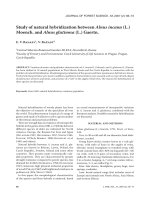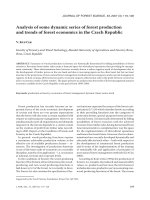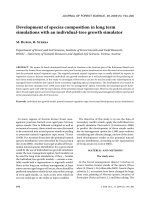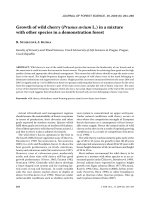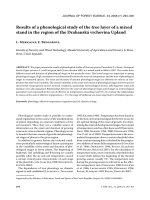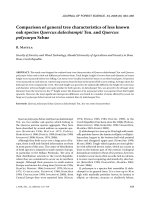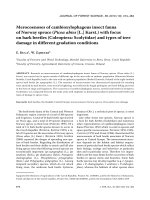Báo cáo lâm nghiệp: " Dynamics of tree species composition and characteristics of available space utilization in the natural forest of the National Nature Reserve Hrončokovský Grúň" pot
Bạn đang xem bản rút gọn của tài liệu. Xem và tải ngay bản đầy đủ của tài liệu tại đây (465.68 KB, 12 trang )
J. FOR. SCI., 54, 2008 (11): 497–508 497
JOURNAL OF FOREST SCIENCE, 54, 2008 (11): 497–508
Variable tree species composition is a typical
feature of primeval forests in the 4
th
and 5
th
verti-
cal forest vegetation zone (S 2004). Diverse
forest ecosystems are characterized by complicated
internal relationships resulting from different eco-
logical requirements of individual tree species, their
different growth capabilities and different physical
age they can reach. is is reflected in stand struc-
ture as well as in the character and course of
developmental processes. Volume and quality of
produced biomass, and fulfilling the non-produc-
tion functions depend on the stand structure (S-
2004), the formation of which is determined
by regeneration processes in natural as well as in
commercial forests. e higher the number of tree
species in both the adult stand and young growth,
the more demanding and complicated the regenera-
tion phytotechnique. In natural forests, the course
and extent of regene-ration processes are affected
by physical mortality of individual tree species. Re-
Dynamics of tree species composition and characteristics
of available space utilization in the natural forest
of the National Nature Reserve Hrončokovský Grúň
M. S, M. B
Faculty of Forestry, Technical University in Zvolen, Zvolen, Slovakia
ABSTRACT: e paper deals with changes in the diameter structure of particular tree species as well as with the
selected production characteristics in the mixed virgin forest Hrončokovský Grúň. e object of the analysis was the
diameter structure of particular tree species in developmental stages of virgin forest. e data were collected in the
years 1972, 1982, 1992 and 2002 on permanent research plots 71.5 × 70 m (0.5 ha) in size. Diameter frequencies for
particular tree species were approximated with the curves. e goal was to evaluate their mortality or vitality according
to the strength of the correlation in developmental stages of the virgin forest. A strong correlation was confirmed in the
advanced phase of the growth stage, whereas the strongest correlation was recorded for the ash. Beech as a virgin forest
bearer had a medium strong correlation. For the advanced phase of the optimum stage lower values of the correlation
coefficients were determined for all tree species. e growth vitality and thus lower mortality was characteristic of ma-
ple and ash. Beech as a structure bearer is characterized by higher mortality and therefore a weaker correlation. In the
breakdown stage the highest mortality was found for the fir, which is confirmed by the lowest value of the correlation
coefficient. In the advanced phase of the optimum stage the highest mortality was recorded for the beech. e analysis
of growth and production relationships was conducted on the transects of 3 permanent research plots 10 × 71.5 m in
size (i.e. total size of 2,145 m
2
). e analysis of the growth relationships between the crown and stem volume confirmed
a strong correlation for beech and fir despite the fact they are present in the entire height profile of the virgin forest.
e reason is that both of them are the shade-tolerant tree species. High correlation coefficients for maple and ash
(R = 0.82 and R = 0.84) are the evidence of a distinctive influence of the assimilatory apparatus on the stem volume.
e reason is the fact that both tree species are situated in the upper tree layer and have relatively enough space for
the crown growth. e productive utilization of the crown space in the virgin forest confirmed the dominance of the
beech as a structure bearer.
Keywords: natural forest; developmental stage; utilization of production space; structure
Supported by the Scientific Grant Agency VEGA of the Slovak Research and Development Agency of the Ministry of Education
of the Slovak Republic, Project No. 0082-06.
498 J. FOR. SCI., 54, 2008 (11): 497–508
liable information on natural regeneration patterns
allows the application of underlying mechanisms in
shorter time spans within the framework of close
to nature silviculture (K 1989, 1995; K,
S 1995).
As regards the tree species composition of the
primeval forest in the National Nature Reserve
(NNR) Hrončokovský Grúň, this primeval forest
represents the culmination of tree species diversity
(K 1995). is tree species composition is
a basic prerequisite for the markedly diversified
spatial structure of a natural forest (K 1995).
e first results about the formation and volume of
coarse woody debris within the developmental cycle
were published by S and S (2002). e
authors found that in the primeval forest of the NNR
Hrončokovský Grúň, which belongs to the most
species-diversified virgin forests of the 4
th
and 5
th
ve-
getation zones (six tree species), the necromass vo-
lume is high within the whole developmental cycle,
reaching the highest values in the optimum stage.
A significant increase of dead wood at this stage is
caused by the phase shift of silver fir, dying back in
the second developmental cycle compared to beech
as a determinant tree species of this natural forest.
Regeneration processes of individual tree spe-
cies in this primeval forest are further complicated
partly because of different ecological requirements
of individual tree species during germination, es-
tablishment and growth of seedlings (K 1995;
S 2004).
e Hrončokovský Grúň primeval forest with its
diverse tree species composition and differentiated
physical ages of trees has some specific features. In
addition to the fluctuation of the biomass volume,
caused by the competition pressure of individual
tree species and different maximum physical age,
significant differences were found in the processes
of the formation and structure of dead wood. A
significant increase in the necromass volume in
the optimum stage, confirming the observations
of S and S (2002), is caused by high
production potential and longevity of fir, which sur-
vives until the second developmental cycle, where
beech is the main species. Fir is the predominant
species of the standing necromass, which reflects
its high static stability, whereby the gradual de-
cline of living trees is caused by their high age (the
breakdown stage). In the breakdown stage, there is a
period with unsuitable ecological conditions for the
establishment and growth of the subsequent gen-
eration resulting from different maximum physical
ages of tree species and their different vitality. A
continuous regeneration process starts at the time
when a tree species dies out, which forms a gap in
the available crown space of the size of a group at
least (0.02 ha).
e papers dealing with research on virgin forests
composed of more tree species were mainly fo-
cused on the diameter structure and on the growth
processes of particular tree species (J,
S 1995; J, S 2001;
J et al. 2005). e utilization of productive
growth space by the tree species and the relations
between crown and stem volume were studied above
all in selection forests (S, V 2007).
e analysis of growth space economy by particular
tree species on tending research plots, i.e. what the
relationship between the tree and the stand produc-
tivity is like, was presented by U (2002). e
results confirmed a significant relationship between
the increase in the tree growth space and the stem
volume increment.
Growth and competition relationships between
the tree species with different ecological demands
on light and nutrients in the virgin forests have not
been presented in the literature yet.
e objective of this study is to answer the follow-
ing questions:
– How is the production space utilized by crowns of
different tree species in individual developmental
stages of natural forest and what is its dynamics
within the time span of 30 years?
– What is the temporal change of canopy closure in
individual developmental stages?
– How does the tree species composition change
during 30 years, according to developmental
stages?
– To assess the growth potential of individual tree
species within the production space of a natural
forest, an analysis of crown and trunk volumes
was performed.
MATERIAL AND METHODS
e National Nature Reserve Hrončokovský Grúň
was established in 1964. e area is 55.30 ha with a
protection zone of 112.83 ha. e reserve is situated
in the forest management unit Hronec, compart-
ments 298, 299, 300 and 301. It is located in the
geographical unit Slovenské Rudohorie Mountains
in Central Slovakia (48°43'N, 19°35'E), the altitudes
range between 730 and 1,050 m a.s.l., slope aspect
is east to southeast, and slope angle ranges from
15° to 25°.
e average annual temperature is 5°C, precipita-
tion totals are 800 to 850 mm per year. e bedrock
is formed of andesite tuff agglomerates and pyro-
J. FOR. SCI., 54, 2008 (11): 497–508 499
Table 1. e utilization of available growth space according to tree species and levels in the natural forest of NNR Hrončokovský Grúň in a time span of 30 years (growth stage)
(PRP 1)
Year
Upper level UAS
s
/UAS
L
(%)
Intermediate level UAS
s
/UAS
L
(%)
Total UAS
(%)
species C
kd
(m
3
) species C
kd
(m
3
) species C
kd
(m
3
)
1972
Spruce 1,655.76 17.76 Spruce 13.07 0.14 Spruce 1,668.83 8.95
Beech 1,305.58 14.01 Beech 221.1 2.37 Beech 1,526.68 8.19
Maple 1,215.79 13.04 Maple 22.09 0.24 Maple 1,237.88 6.64
Fir 75.16 0.81 Fir 0.00 Fir 75.16 0.40
Total 4,252.30 45.62 Total 256.26 2.75 Total 4,508.55 24.18
1982
Spruce 1,735.12 16.98 Spruce 68.68 0.67 Spruce 1,803.80 8.83
Beech 1,900.25 18.60 Beech 179.71 1.76 Beech 2,079.96 10.18
Maple 1,249.23 12.23 Maple 33.01 0.32 Maple 1,282.24 6.27
Fir 123.37 1.21 Fir 0.00 Fir 123.37 0.60
Total 5,007.97 49.01 Total 281.40 2.75 Total 5,289.37 25.88
1992
Spruce 1,755.27 16.77 Spruce 0.00 Spruce 1,755.27 8.39
Beech 2,618.33 25.02 Beech 226.19 2.16 Beech 2,844.52 13.59
Maple 872.51 8.34 Maple 37.63 0.36 Maple 910.14 4.35
Fir 50.29 0.48 Fir 0.00 Fir 50.29 0.24
Total 5,296.40 50.61 Total 263.82 2.52 Total 5,560.22 26.57
2002
Spruce 2,038.88 19.31 Spruce 0.00 Spruce 2,038.88 9.66
Beech 3,105.07 29.41 Beech 386.85 3.66 Beech 3,491.92 16.54
Maple 1,060.15 10.04 Maple 172.03 1.63 Maple 1,232.18 5.84
Fir 0.00 Fir 0.00 Fir 0.00
Total 6,204.10 58.76 Total 558.88 5.29 Total 6,762.98 32.03
C
kd
– crown volume, UAS
s
– utilization of the available crown space of tree species, UAS
L
– utilization of the available crown space of level, UAS – total utilization of available crown
space
500 J. FOR. SCI., 54, 2008 (11): 497–508
clastics. e predominant soil types are Eutric and
Dystric Cambisols, soil is sandy to loamy, with a
low share of rocks, well aerated, well drained, fresh,
moderately deep to deep, moderately acidic, with a
low content of available nutrients.
Four phytosociological units (groups of forest
types) are represented in the reserve: Abieto-
Fagetum, Fageto-Abietum, Fageto-Aceretum and
Fraxineto-Aceretum. Except for Abieto-Fagetum
belonging to the 5
th
fir-beech forest vegetation zone
and represented by the forest type Filices – Asperula
odorata – Oxalis acetosella – Prenanthes purpu-
rea, all remaining plant communities belong to the
6
th
spruce-beech-fir forest vegetation zone. In terms
of the tree species composition, this natural forest is
composed of European beech (Fagus sylvatica L.),
silver fir (Abies alba Mill.), Norway spruce (Picea
abies L. Karst.), sycamore maple (Acer pseudopla-
tanus L.), European ash (Fraxinus excelsior L.) and
wych elm (Ulmus glabra L.) and belongs to the
most tree-species-diversified forest ecosystems in
Europe.
e analysis of changes in the tree species com-
position in particular diameter classes according to
the developmental stages of the virgin forest within
a 30-year period was based on data from the full
callipering of the permanent research plots, calcu-
lated per 1 ha. Developmental stages were identified
according to the diameter structure at the estab-
lishment of permanent research plots by professor
Korpeľ. In subsequent decades the measurements
and evaluations of permanent research plots were
repeated periodically.
e utilization of productive growth space of the
virgin forest by particular tree species and the share
of the tree species in the total crown canopy in tree
layers were calculated according to data from the
transects of PRP (715 m
2
) in the particular decades
of measurement (1972–2002). ese dendrometric
characteristics were measured:
– tree height (
h) – to the nearest 0.5 m,
– crown base height (
h
Z
) – to the nearest 0.5 m,
– dbh – to the nearest 1 mm,
– crown width – four directions
x
1
–x
4
, to the nearest
0.1 m,
– position of the tree – orthogonal coordinates
x, y,
to the nearest 0.1 m.
e analysis of the relation between the crown
volume and the stem volume according to the tree
species was based on data from the transects and
years of measurement for the entire developmental
cycle of the virgin forest.
A’s (1961) formula was used for the calcu-
lation of crown volume (C
k
):
For broadleaved species:
π
C
k
= –––– b
2
l (m
3
)
8
For coniferous species:
π
C
k
= –––– b
2
l (m
3
)
12
where:
b – crown diameter (m),
l – crown length (m).
e crown (C
L
) volume within the level was cal-
culated as the sum of volumes of all crowns in the
transect:
C
L
=
∑
C
k
(m
3
)
e available crown space (V
L
) of the particular
level was calculated using the following formula:
h
0
V
L
= S
tr
× –––– (m
3
)
3
where:
S
tr
– area of transect (m
2
),
h
0
– upper tree height (m).
e upper tree height is defined as the average
height of 10% of the thickest trees in the transect.
e formula for the calculation of utilization of
available crown space (UAS
L
):
C
L
UAS
L
= ––––– × 100 (%)
V
L
Trunk volumes of individual tree species were
determined using the volumetric tables of P
and P (1992).
RESULTS
Utilization of available crown space
and canopy closure
e information on the basic characteristics of
natural forest at the growth stage is given in Table 1.
At the beginning, it is necessary to emphasize that
spruce occurs only on PRP 1, because this plot is
located in a part of the reserve with different bed-
rock (granodiorite). When the upper layer of natu-
ral forest during the last 30 years is evaluated, it is
apparent that except for the first measurement in
1972, beech is a predominant species utilizing the
available growth space of the natural forest all the
time. Its share in the utilization of available growth
space permanently increased and reached 29.41% in
the upper layer in 2002. When all species are evalu-
ated jointly, the utilization of available crown space
exhibited an increasing trend and reached 58.76%
in 2002. At this plot, the intermediate layer is partly
J. FOR. SCI., 54, 2008 (11): 497–508 501
Table 2. e utilization of available growth space according to tree species and levels in the natural forest of NNR Hrončokovský Grúň in a time span of 30 years (breakdown stage)
(PRP 2)
Year
Upper level UAS
s
/UAS
L
(%)
Intermediate level UAS
s
/UAS
L
(%)
Total UAS
(%)
species C
kd
(m
3
) species C
kd
(m
3
) species C
kd
(m
3
)
1972
Beech 1,705.73 17.28 Beech 20.60 0.21 Beech 1,726.33 8.75
Spruce 262.72 2.66 Spruce 0.00 Spruce 262.72 1.33
Fir 284.56 2.88 Fir 4.12 0.04 Fir 288.68 1.46
Ash 245.22 2.48 Ash 0.00 Ash 245.22 1.24
Maple 175.35 1.78 Maple 2.62 0.03 Maple 178.04 0.90
Total 2,673.58 27.08 Total 27.41 0.28 Total 2,700.99 13.68
1982
Beech 2,063.75 22.14 Beech 74.00 0.79 Beech 2,137.75 11.47
Spruce 0.00 Spruce 0.00 Spruce 0.00
Fir 434.07 4.66 Fir 14.85 0.16 Fir 448.92 2.41
Ash 552.36 5.93 Ash 0.00 Ash 552.36 2.96
Maple 300.23 3.22 Maple 0.00 Maple 300.23 1.61
Total 3,350.41 35.95 Total 88.85 0.95 Total 3,439.26 18.45
1992
Beech 4,779.09 51.62 Beech 657.11 7.10 Beech 5,436.20 29.36
Spruce 0.00 Spruce 0.00 Spruce 0.00
Fir 125.43 1.35 Fir 50.12 0.54 Fir 175.55 0.95
Ash 616.72 6.66 Ash 0.00 Ash 616.72 3.33
Maple 267.25 2.89 Maple 57.97 0.63 Maple 325.22 1.76
Total 5,788.49 62.52 Total 765.20 8.26 Total 6,553.69 35.39
2002
Beech 5,372.89 55.09 Beech 837.70 8.59 Beech 6,210.59 31.84
Spruce 0.00 Spruce 0.00 Spruce 0.00
Fir 150.13 1.54 Fir 65.41 0.67 Fir 215.54 1.10
Ash 681.32 6.99 Ash 0.00 Ash 681.32 3.49
Maple 294.87 3.02 Maple 41.81 0.43 Maple 336.68 1.73
Total 6,499.21 66.64 Total 944.92 9.69 Total 7,444.13 38.16
C
kd
– crown volume, UAS
s
– utilization of the available crown space of tree species, UAS
L
– utilization of the available crown space of level, UAS – total utilization of available crown
space
502 J. FOR. SCI., 54, 2008 (11): 497–508
filled by crowns as well. However, its utilization by
crowns of individual species is markedly low, rang-
ing from 2.52% to 5.29%, with the predominance
of beech. Total utilization of available crown space
ranges from 24.18% (in 1972) to 32.03% (in 2002).
e situation at PRP 2 (initial phase of the break-
down stage) is characterized in Table 2. In spite of
the sporadic presence of spruce in the upper layer
in 1972, beech is a dominant species. Other species
also occur in the upper layer, particularly sycamore
maple, European ash and silver fir, and their propor-
tion varies from 1.5% to 7%. As the breakdown con-
tinued slowly through dying-off of single trees, the
reaction of beech crowns is quite rapid despite its
high physical age. Beech increased the total volume
of its crowns from 1,705.7 m
3
in 1972 to 5,372.9 m
3
in 2002. A threefold increase in the crown volume
documents the high growth vitality of this tree spe-
cies. e intermediate layer of the natural forest is
filled by European beech, silver fir, and sycamore
maple on this plot, whereby the utilization of avail-
able growth space by these species is low as well.
In spite of the heterogeneous tree species structure
with different light requirements of individual spe-
cies, the natural forest does not have a differentiated
height structure. On the other hand, the utilization
of the available growth space of natural forest by
crowns is higher than in the initial phase of growth
stage.
e utilization of available crown space by the
crowns of individual tree species at the optimum
stage (PRP 3) of natural forest Hrončokovský Grúň is
documented in Table 3. In the upper layer, the space
utilization by all tree species ranged from 30.41% in
1972 to 83.91% in 2002, with beech as a dominant
species. e increase in the crown volume of beech
between 1972 and 2002 was almost threefold. Euro-
pean ash is relatively strongly represented in the up-
per layer, with the total crown volume of 1,733.56 m
3
in 2002, representing 19.93% of the available growth
space. e intermediate layer was filled by beech
(disappearing after 1992), partly by fir and maple. At
this developmental stage, even the lower layer of the
natural forest is slightly filled by fir.
e analysis of all three developmental stages of
the virgin forest in the NNR Hrončokovský Grúň
confirmed that in spite of the species richness of the
tree layer and a variety of ecological requirements of
tree species, height differentiation is not consider-
able. Total utilization of available growth space was
the highest at the breakdown stage, the lowest at the
optimum stage.
Canopy closure level, defined as the sum of verti-
cal projections of tree crowns onto the ground, is
characterized in Table 4. As the year 2002 is evalu-
ated, according to the developmental stages we can
state that the highest value of canopy closure was
recorded at the optimum stage (172.51%), the low-
est at the growth stage (125.92%). e low values
of canopy closure at the breakdown stage in 1972
and 1982 were probably caused by dying-off of large
beech and maple trees and by deceleration of break-
down during the last 20 years. e fluctuation of
this characteristic at PRP 1 (growth stage) is caused
by the same mechanism, the trees of the previous
generation are dying off, including fir.
Dynamics of diameter structure
in natural forest
To explain the mechanisms of tree species persis-
tence during the observation period of 30 years, we
fitted diameter class numbers during 30 years to
polynomials of the 3
rd
and 4
th
degree (Figs. 1 to 3). In
PRP1
R
2
= 0.6809
R
2
= 0.3251
R
2
= 0.8339
R
2
= 0.4155
R
2
= 0.7387
0
10
20
30
40
50
60
70
10 20 30 40 50 60 70 80 90
Diameter classes
Pcs/ha
Fagus sylvatica
Abies alba
Fraxinus excelsior
Acer pseudoplatanus
Picea abies
Fig. 1. Dynamics of diameter structure of natural forest NNR Hrončokovský Grúň on PRP 1 (growth stage) in time span
30 years
PRP 1
(pcs/ha)
Fagus sylvatica
Picea abies
Abies alba
Fraxinus excelsior
Acer pseudoplatanus
J. FOR. SCI., 54, 2008 (11): 497–508 503
Table 3. e utilization of available growth space according to tree species and levels in the natural forest of NNR Hrončokovský Grúň in a time span of 30 years (optimal stage)
(PRP 3)
Year
Upper level UAS
s
/UAS
L
(%)
Intermediate level UAS
s
/UAS
L
(%)
Lower level UAS
s
/UAS
L
(%)
Total UAS
(%)
species C
kd
(m
3
) species C
kd
(m
3
) species C
kd
(m
3
) species C
kd
(m
3
)
1972
Beech 1,799.42 23.73 Beech 64.15 0.85 Beech 0.00 Beech 1,863.57 8.19
Ash 369.64 4.87 Ash 0.00 Ash 0.00 Ash 369.64 1.62
Fir 79.59 1.05 Fir 72.53 0.96 Fir 7.85 0.10 Fir 159.97 0.70
Maple 57.36 0.76 Maple 16.11 0.21 Maple 0.00 Maple 73.47 0.32
Total 2,306.01 30.41 Total 152.79 2.01 Total 7.85 0.10 Total 2,466.65 10.84
1982
Beech 3,517.50 43.41 Beech 27.24 0.34 Beech 0.00 Beech 3,544.74 14.55
Ash 586.61 7.22 Ash 0.00 Ash 0.00 Ash 586.61 2.41
Fir 267.36 3.29 Fir 129.17 1.59 Fir 0.00 Fir 396.53 1.63
Maple 83.28 1.03 Maple 38.58 0.47 Maple 0.00 Maple 121.86 0.50
Total 4,454.75 54.85 Total 194.99 2.40 Total 0.00 Total 4,649.74 19.08
1992
Beech 4,144.69 48.16 Beech 684.59 7.96 Beech 0.00 Beech 4,829.28 18.71
Ash 751.36 8.73 Ash 0.00 Ash 0.00 Ash 751.36 2.91
Fir 134.16 1.56 Fir 9.20 0.11 Fir 15.75 0.18 Fir 159.11 0.62
Maple 41.87 0.49 Maple 85.36 0.99 Maple 0.00 Maple 127.23 0.49
Total 5,072.08 58.94 Total 779.15 9.05 Total 15.75 0.18 Total 5,866.98 22.73
2002
Beech 5,192.83 59.70 Beech 0.00 Beech 0.00 Beech 5,192.83 19.90
Ash 1,733.56 19.93 Ash 0.00 Ash 0.00 Ash 1,733.56 6.72
Fir 155.49 1.79 Fir 31.68 0.36 Fir 46.18 0.53 Fir 233.35 0.90
Maple 216.78 2.49 Maple 65.34 0.75 Maple 0.00 Maple 282.12 1.09
Total 7,298.66 83.91 Total 97.02 1.12 Total 46.18 0.53 Total 7,441.86 28.83
C
kd
– crown volume, UAS
s
– utilization of the available crown space of tree species, UAS
L
– utilization of the available crown space of level, UAS – total utilization of available crown
space
504 J. FOR. SCI., 54, 2008 (11): 497–508
addition to the analysis of living trees, this procedure
indirectly evaluates the variability of the dying-off
of trees within individual developmental stages. In
the advanced phase of the growth stage, the closest
relationship (R = 0.91) was found for European ash
(Fig. 1), documenting that ash is preferentially rep-
resented in the upper forest layer, is physiologically
vital, which is manifested in a slow self-thinning
during the period of 30 years. A high correlation
(R = 0.85) was also found for Norway spruce, which
is still vital because of a lower age and will die off
during the optimum stage. e weakest relation-
ship was observed in the case of silver fir (R = 0.56),
which is rapidly declining in the upper layer, and its
next generation in the lower layer suffers from in-
terspecific competition and is occasionally damaged
by the falling of trees of the upper layer. European
beech as the bearer of the structure of this natural
forest just starts to dominate from the aspect of yield
and function at this stage. Because of the dying-off
of trees of the upper layer and damage to the lower
layer by falling trees the correlation index for beech
was R = 0.82, which is significantly less than for Eu-
ropean ash. Sycamore maple, which together with
beech starts to dominate in the lower and intermedi-
ate layers, has a correlation index of R = 0.64, which
is understandable concerning the behaviour of the
virgin forest at this stage.
Trends of tree species persistence in the break-
down stage exhibit weaker correlations for almost
all tree species (Fig. 2). Like in the optimum stage,
the closest relationship was observed for Euro-
pean ash (R = 0.82), reflecting a low mortality of
this species during the last 30 years. An equally
close correlation was recorded for sycamore ma-
ple (R = 0.85) and European beech (R = 0.80). The
highest mortality was recorded in silver fir, where
the correlation index is the lowest, namely R = 0.71.
On PRP 3, which was described as an advanced
phase of the optimum stage, the correlations of the
dynamics of mortality along the temporal gradient
are generally less tight (Fig. 3). The closest correla
-
tion was found for sycamore maple (R = 0.88) and
European ash (R = 0.83), both reaching mostly the
upper layer and being physiologically vital. Beech
as a dominant species and the bearer of structure
has relatively high dynamics of mortality within the
whole vertical profile of the natural forest and thus
exhibits a moderately close relationship (R = 0.64).
Silver fir, representing two generations on this plot,
exhibited the lowest correlation, which is caused by
the relatively fast dying-off of the older fir genera-
tion. The individuals of the subsequent generation
of fir growing in the lower layer become damaged
to various degrees by falling trees of the previous
fir generation.
Table 4. Canopy closure level (%) in NNR Hrončokovský
Grúň in a time span of 30 years according to developmental
stages
PRP
Year
1972 1982 1992 2002
1 103.21 115.81 107.40 125.92
2 57.49 87.68 116.96 134.22
3 94.51 137.41 125.77 172.51
PRP 1 – growth stage, PRP 2 – breakdown stage, PRP 3 – opti-
mal stage
Fig. 2. Dynamics of diameter structure of natural forest NNR Hrončokovský Grúň on PRP 2 (breakdown stage) in time span
30 years
PRP2
R
2
= 0.653
R
2
= 0.5084
R
2
= 0.7559
R
2
= 0.716
0
10
20
30
40
50
60
70
10 20 30 40 50 60 70 80 90
Diameter classes
Pcs/ha
Fagus sylvatica
Abies alba
Fraxinus excelsior
Acer seudoplatanus
PRP 2
(pcs/ha)
Fagus sylvatica
Abies alba
Fraxinus excelsior
Acer pseudoplatanus
J. FOR. SCI., 54, 2008 (11): 497–508 505
Growth relationships of tree species
in the natural forest
e volume growth of a tree is most influenced
by the volume of the assimilatory apparatus – tree
crown. To assess the growing processes of individual
tree species in the primeval forest, an analysis of
relationships between crown volume and trunk vol-
ume was done. e analysis of this relationship for
European beech as a species forming the skeleton
Fig. 3. Dynamics of diameter structure of natural forest NNR Hrončokovský Grúň on PRP 3 (optimum stage) in time span 30 years
Abies alba
y = 0.0158x
1.1451
R
2
= 0.6848
0
5
10
15
20
25
0 20 40 60 80 100 120 140 160 180 200
Crown volume (m
3
)
Trunk volume (m
3
)
Fagus sylvatica
y = 0.0927x
0.5714
R
2
= 0.6457
0
2
4
6
8
10
0 500 1,000 1,500 2,000 2,500
Crown volume (m
3
)
Trunk volume (m
3
)
Fig. 4. The relationship
between crown and trunk
volume, European beech
Fig. 5. The relationship
between crown and trunk
volume, silver fir
Abies alba
y = 0.0158x
1.1451
R
2
= 0.6848
0
5
10
15
20
25
0 20 40 60 80 100 120 140 160 180 200
Crown volume (m
3
)
Trunk volume (m
3
)
PRP3
R
2
= 0.413
R
2
= 0.3073
R
2
= 0.686
R
2
= 0.7692
0
10
20
30
40
50
60
70
80
90
100
10 20 30 40 50 60 70 80 90
Diameter classes
Pcs/ha
Fagus sylvatica
Abies alba
Fraxinus excelsior
Acer pseudoplatanus
PRP 3
(pcs/ha)
Fagus sylvatica
Abies alba
Fraxinus excelsior
Acer pseudoplatanus
506 J. FOR. SCI., 54, 2008 (11): 497–508
of this primeval forest confirmed a relatively close
relationship R = 0.80 (Fig. 4). On the other hand,
the index of determination showed that 64% of the
trunk volume growth was determined by the crown
volume and 36% by other factors, e.g. competition
among neighbouring trees or different level of soil
utilization.
Concerning silver fir as another shade-tolerant tree
species of the primeval forest, a similar relationship
was observed (R = 0.82) (Fig. 5). Testing these two
correlation indexes did not confirm a significant dif-
ference between beech and fir. In the case of fir, the
processes of stem growth and increment are similar
to those of beech.
The analysis of growth relationships between
crown and trunk volume in Norway spruce con-
firmed a close correlation, R = 0.75 and index of
determination R
2
= 0.56 (Fig. 6), meaning that the
volume of assimilatory apparatus contributed to
trunk volume by 56%.
e analysis of this relationship for European ash,
which reaches a height of 49 m in this reserve, is
presented in Fig. 7. A high correlation index R = 0.79
indicates a very tight correlation and a 62% effect of
assimilatory apparatus on trunk volume, whereby
only 38% of trunk volume variation was caused by
other factors.
A similar situation was found in sycamore maple
(Fig. 8). A high index of determination R
2
= 0.71
together with a correlation coefficient of 0.84 con-
firmed a similar relationship like in European ash.
e testing of these two correlation coefficients did
not confirm any significant difference. e same ef-
fect was recorded in the analysis of determination
indexes R
2
among European ash, sycamore maple
and European beech.
Fraxinus excelsior y = 0.0075x + 1.2601
R
2
= 0.6259
0
1
2
3
4
5
6
7
0 100 200 300 400 500 600
Crown volume (m
3
)
Trunk volume (m
3
)
Fig. 6. The relationship
between crown and trunk
volume, Norway spruce
Fig. 7. The relationship
between crown and trunk
volume, European ash
Picea abies
y = –9E-06x
2
+ 0.0147x + 2.0671
R
2
= 0.5611
0
2
4
6
8
10
12
0 100 200 300 400 500 600 700 800 900
Crown volume (m
3
)
Trunk volume (m
3
)
y = – 0.000009x
2
+ 0.0147x + 2.0671
J. FOR. SCI., 54, 2008 (11): 497–508 507
DISCUSSION AND CONCLUSION
e natural forest of the nature reserve Hron-
čokovský Grúň with a diverse tree species composi-
tion is a rarity among forest ecosystems of Central
and Eastern Europe (K 1989, 1995). This
diversity is caused by a gradual change of bedrock
on one third of the area of this natural forest. On the
one hand bedrock is andesite, on the other hand it
is granodiorite and siliceous diorite, whereby PRP 1
is situated just on the diorite bedrock, providing
favourable growing conditions for Norway spruce.
On the other hand, PRP 2 and PRP 3 are located in a
part of the reserve with andesite bedrock. ey are
formed of plant communities associated with well
aerated and nutrient-rich Cambisols, which provide
optimum conditions for the growth of European
ash and sycamore maple. In this reserve, ash and
maple reached maximum heights that have ever been
recorded within the research of any broadleaved
natural forest of Slovakia (S 2004). Optimum
environmental conditions caused that the trunk
volume growth is most affected by the capacity of
their assimilatory apparatus, in spite of the fact that
they are both moderately shade-tolerant tree spe-
cies. In the case of these two tree species, improved
soil conditions balanced the lack of sunlight in the
middle and upper third of crown space. e second
factor most affecting the strange correlation is their
height position in the upper level. Here the crowns
have almost self-standing positions. e knowledge
of this problem has not been published yet. Nev-
ertheless, the findings from research of relations
between the parameters of crowns and stem vol-
ume increment on thinning plots confirm this fact
(U 2002). Similar relations were confirmed
for fir and partly for spruce in the selection forest
that represents the advanced phase of growth stage
(S,V 2007). The analysis of tree
number dynamics according to tree species, dia-
meter classes and developmental stages approxi-
mated by polynomial regressions confirmed that fir
dies off in the advanced phase of the growth stage
and at the beginning of the optimum stage, when the
second generation of beech becomes predominant.
e correlation coefficient for fir documents a mod-
erately close relationship.
e analysis of selected yield indicators of indi-
vidual tree species confirmed that under favourable
soil conditions, maple and ash as moderately shade-
tolerant admixed species are able to maintain their
position in the growing space of this natural forest, in
spite of the fact that beech is a dominant species.
R ef e r e n c e s
ASSMANN E., 1961. Waldertragskunde. München, Basel,
Wien, BLV: 361.
JAWORSKI A., SKRZYSEWSKI J., 1995. Vertical stratifica-
tion, structure and dynamics of natural forest stands of the
montane zone in the Łopuszna reserve. Acta Agraria et
Silvestria, Seria Silvestris, 33: 3–37. (In Polish with English
summary).
JAWORSKI A., STRZESKA T., 2001. Species composition,
setup and structure of tree stands in the Oszast nature
reserve. Sylwan, 145: 5–32. (In Polish with English sum-
mary).
JAWORSKI A., KOODZIEJ Z., BARTKOWICZ L., 2005.
Structure and dynamics of stands of primeval character
composed of the little-leaf linden (Tilia cordata Mill.) in the
“Las lipowy Obrożyska” reserve (southern Poland). Journal
of Forest Science, 51: 283–304.
KORPEĽ Š., 1989. Pralesy Slovenska. Bratislava, Veda:
332.
Acer pseudoplatanus
y = 0.1058x
0.5509
R
2
= 0.7122
0
1
2
3
4
5
6
0 200 400 600 800 1,000 1,200
Crown volume (m
3
)
Trunk volume (m
3
)
Fig. 8. e relationship be-
tween crown and trunk
volume, sycamore maple
508 J. FOR. SCI., 54, 2008 (11): 497–508
KORPEĽ Š., 1995. Die Urwälder der Westkarpaten. Stuttgart,
Jena, New York, Fischer Verlag: 310.
KORPEĽ Š., SANIGA M., 1995. Prírode blízke pestovanie lesa.
Zvolen, ÚVVP LVM SR: 158.
PETRÁŠ P., PAJTÍK J., 1992. Sústava česko-slovenských obje-
mových tabuliek drevín. Lesnícky časopis, 37: 49–56.
SANIGA M., 2004. Štruktúra, rastové a regeneračné procesy
prírodného lesa v NPR Hrončokovský Grúň. Ochrana
prírody, 236: 112–124.
SANIGA M., SCHÜTZ J.P.H., 2002. Relation of dead wood
course within the developmental cycle of selected virgin for-
ests in Slovakia. Journal of Forest Science, 48: 512–528.
SANIGA M., VENCÚRIK J., 2007. Dynamika štruktúry
a regeneračné procesy lesov v rôznej fáze prebudovy na
výberkový les v LHC Korytnica. Vedecké štúdie 1/2007 A.
Zvolen, TU: 82.
UTSCHIG H., 2002. Analyze der Standraumökonomie von
Einzelbäumen auf langfristig beobachteten Versuchsflächen
– Methoden, Programmentwicklung und erste Ergebnisse.
Forstwissenschaftliches Centralblatt, 121: 335–348.
Received for publication May 28, 2008
Accepted after corrections July 11, 2008
Corresponding author:
Prof. Ing. M S, DrSc., Technická univerzita vo Zvolene, Lesnícka fakulta, T. G. Masaryka 24,
960 53 Zvolen, Slovensko
tel.: + 421 455 206 234, fax: + 421 452 332 654, e-mail:
Dynamika zmeny drevinovej štruktúry a charakteristík využitia rastového
priestoru vo vektore času v pralese NPR Hrončokovský Grúň
ABSTRAKT: Prales v NPR Hrončokovský Grúň patrí z hľadiska drevinovej štruktúry medzi bohaté. Zastúpenie
drevín smrek, jedľa, buk, jaseň štíhly, javor horský a brest ho zaraďuje medzi botanické rarity. Práca pojednáva
o dynamike zmeny hrúbkovej štruktúry jednotlivých drevín ako aj o ich vybraných produkčných charakteristikách
v tomto pralese. Predmetom analýzy bola hrúbková štruktúra jednotlivých drevín v jednotlivých vývojových štádiách
pralesa, zisťovaná priemerkovaním v rokoch 1972, 1982, 1992 a 2002 na trvalých výskumných plochách (TVP) o vý
-
mere 71,5 × 70 m (0,5 ha). Hrúbkové početnosti stromov jednotlivých drevín, zistené v uvedených rokoch merania,
boli aproximované krivkami. Cieľom uvedenej závislosti bolo posúdiť ich mortalitu, resp. vitalitu na základe tesnosti
korelácie v jednotlivých vývojových štádiách pralesa. Najtesnejšia závislosť bola potvrdená v pokročilej fáze štádia
dorastania, pričom najvyššiu závislosť vykazoval jaseň štíhly. Buk ako nositeľ štruktúry pralesa mal závislosť stredne
tesnú. Pokročilá fáza štádia optima je charakteristická nižšími hodnotami korelačných koeficientov všetkých drevín.
Rastovú vitalitu a tým menšiu mortalitu si udržiavali javor a jaseň. Buk ako nositeľ štruktúry sa vyznačuje vyššou
mortalitou a tým menej tesnou koreláciou. V štádiu rozpadu sa potvrdila najväčšia mortalita pri drevine jedľa,
čo potvrdzuje najnižší korelačný koeficient. Rozbor rastových a produkčných vzťahov bol vykonaný z tranzektov
troch TVP, ktoré mali výmeru 10 × 71,5 m, tj. celkom 2 145 m
2
. Analýza rastových vzťahov medzi objemom koruny
a objemom kmeňa potvrdila vysokú korelačnú závislosť pri drevine buk a jedľa napriek tomu, že sa nachádza v ce
-
lom výškovom profile pralesa. Dôvodom je ich vysoká tolerancia na svetlo a optimálne rastové podmienky. Vysoký
korelačný koeficient pri drevine javor a jaseň (
R = 0,82, resp. R = 0,84) svedčí o významnom vplyve asimilačného
aparátu na objem kmeňa. Dôvodom je skutočnosť, že obe dreviny sa nachádzajú v porastovej úrovni a majú relatívne
autonómne postavenie svojich korún. Produkčné využitie rastového priestoru pralesa potvrdilo dominanciu buka
ako nositeľa štruktúry.
Kľúčové slová: prales; vývojové štádium; využitie rastového priestoru; štruktúra
